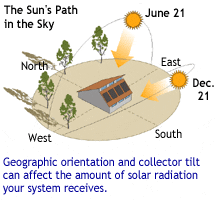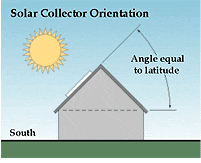solar collector orientation and tilt

The east to west paths of the sun on June 21 and December 21. On June 21, the sun is more directly overhead than on December 21, when the path of the sun tends more toward the south.
Collector orientation
Solar electric and hot water collectors should be oriented geographically to maximize the amount of daily and seasonal solar energy that they receive. In general, the optimum orientation for a solar collector in the northern hemisphere is true south. However, recent studies have shown that, depending on your location and collector tilt, your collector can face up to 90° east or west of true south without significantly decreasing its performance.
You'll also want to consider factors such as roof orientation (if you plan to mount the collector on your roof), local landscape features that shade the collector daily or seasonally, and local weather conditions (foggy mornings or cloudy afternoons), as these factors may affect your collector's optimal orientation.
Collector tilt
 |
Today, most domestic and small commercial solar electric and solar water heating collectors are mounted flat on the roof. This is more aesthetically pleasing than rack-mounted collectors, which stick up from the roof at odd angles. Thus, most collectors have the same tilt as the roof.
Although the optimal tilt angle for the collector is an angle equal to your latitude, fixing your collector flat on an angled roof will not result in a big decrease in system performance. You will, however, want to take roof angle into account when sizing your system.
